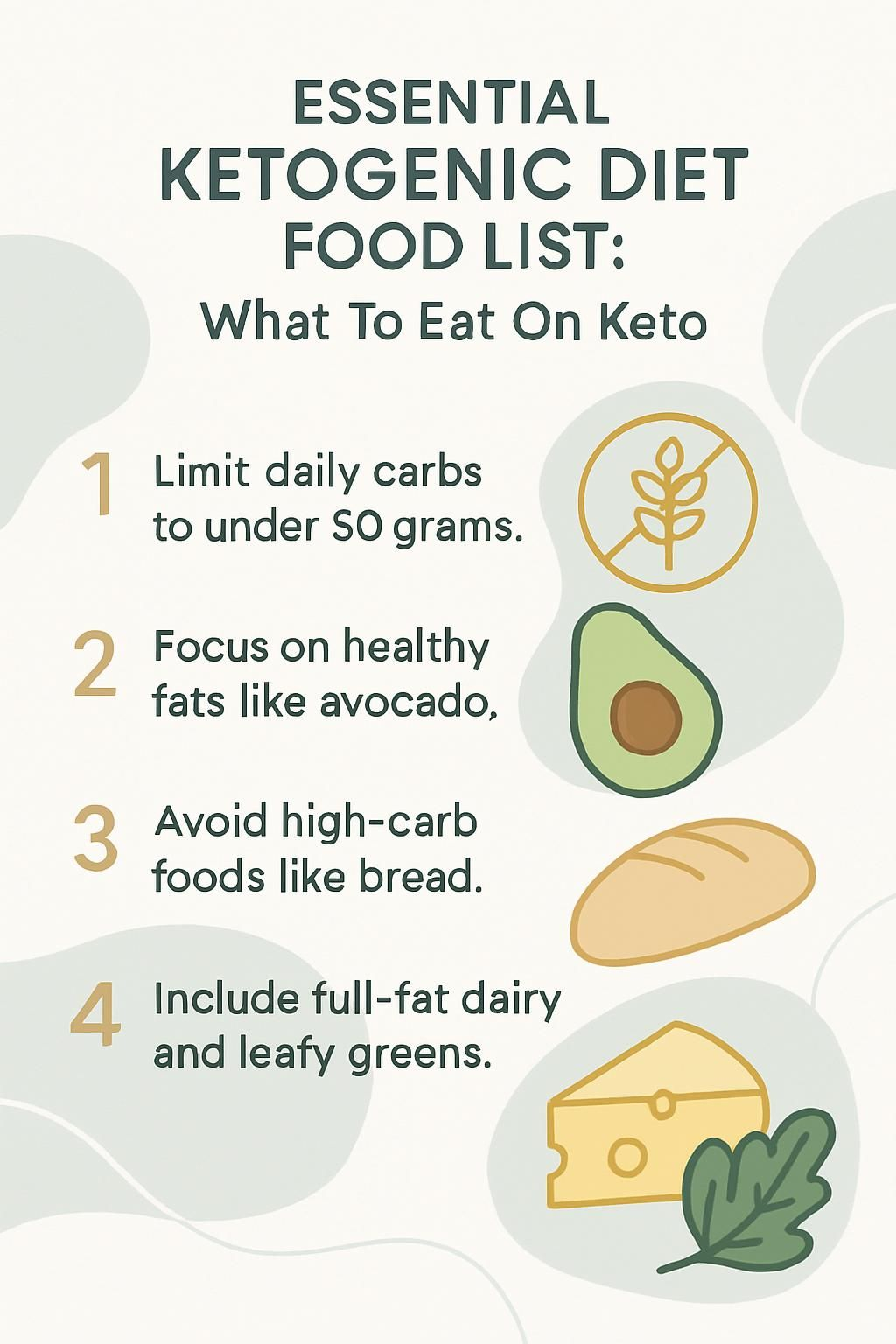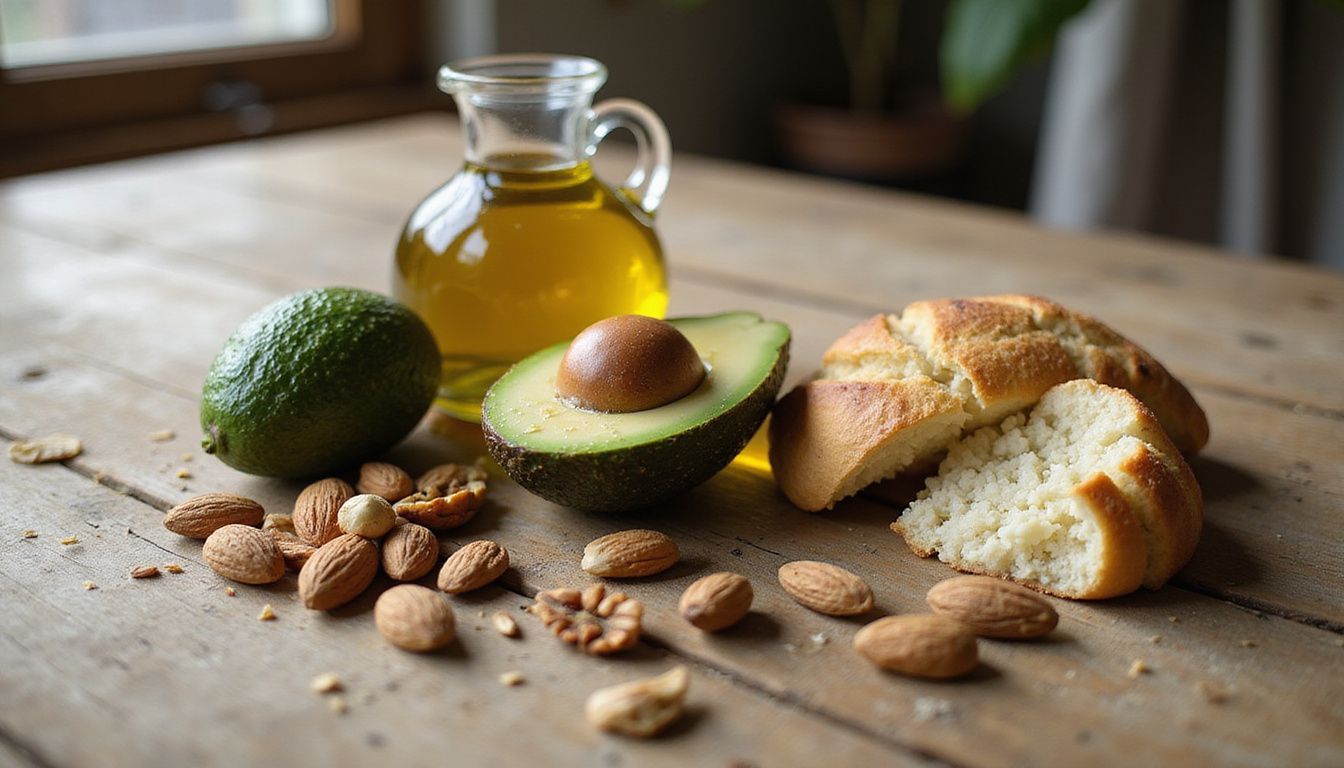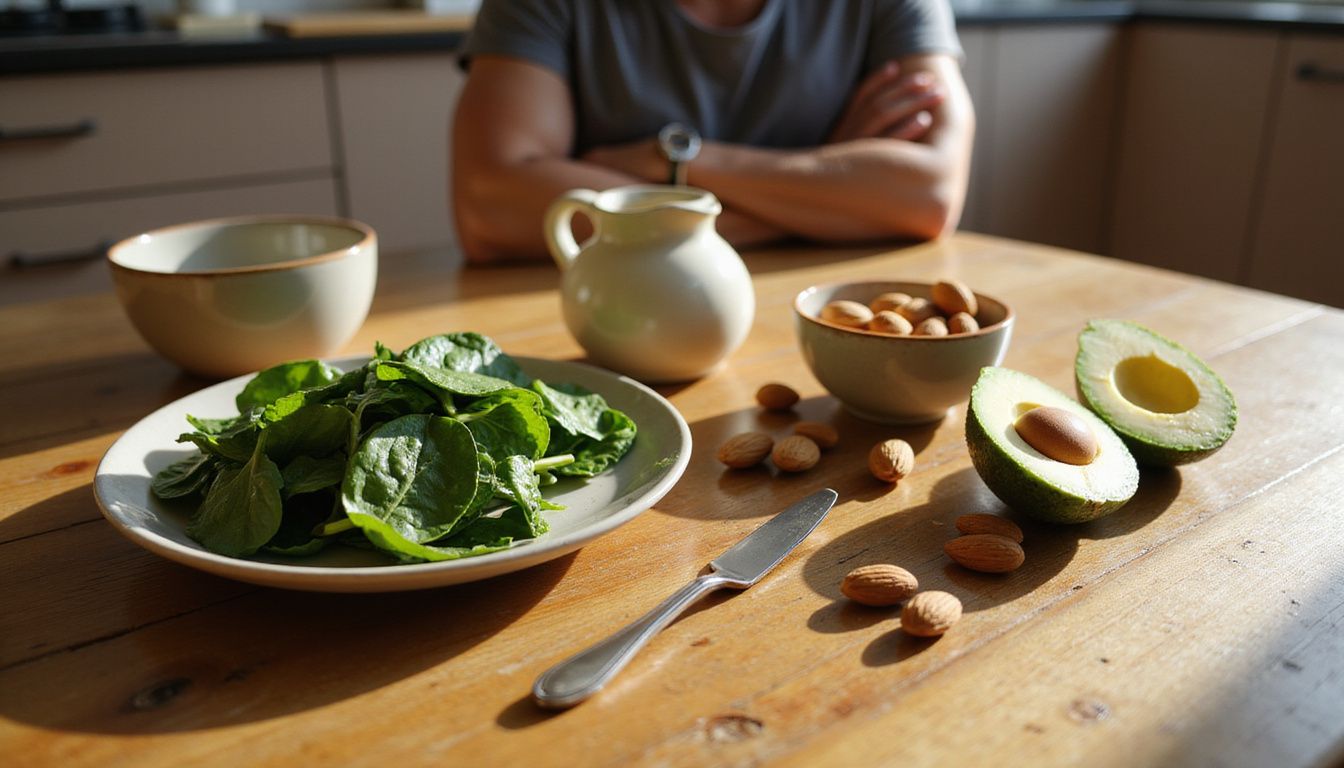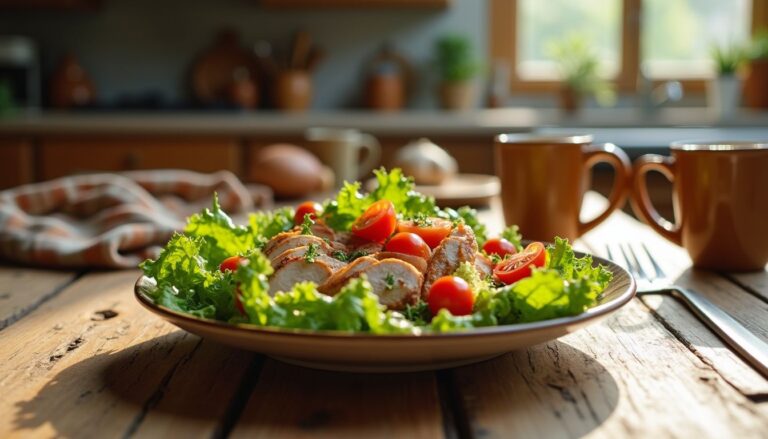Essential Ketogenic Diet Food List: What To Eat On Keto
Our Nutrition Assistant AI Suite will transform your body. You will lose fat, get toned, and build muscle. Gain confidence and optimal health.
Starting a keto diet can feel confusing. I wanted a simple ketogenic diet food list I could trust, one that helped with weight management and steady energy. Research from Harvard Health Publishing explains that keeping carbs very low and choosing healthy fats can make a real difference.
After digging into the evidence, I learned which fats, proteins, vegetables, nuts, seeds, and dairy fit a keto meal plan. The guide below makes planning meals easier and more consistent.
Key Takeaways
- The ketogenic diet focuses on healthy fats like avocado, olive oil, and fatty fish, while keeping daily carbohydrates under 50 grams.
- Research from Harvard Health Publishing and Diabetes Ther. (2018) links keto with weight loss and better insulin sensitivity for some people with type 2 diabetes.
- Full-fat dairy, eggs, nuts, seeds, leafy greens, and other non-starchy vegetables form the core of a balanced keto meal plan.
- Avoid high-carb foods, including bread, rice, pasta, legumes, starchy vegetables like potatoes or corn, and sugary snacks to maintain ketosis.
- The ketogenic diet began in 1921 for epilepsy care. Today it is also used for blood sugar control and long-term weight management.

What is the Ketogenic Diet?

The ketogenic diet is a very low carbohydrate, high fat eating plan that changes how the body gets fuel. When I cut carbs, my body shifts to burning fat for energy. This state is called ketosis.
In ketosis, the liver makes ketone bodies. These act as a steadier fuel, and they help stabilize blood sugar. On keto, I choose fats like avocado, olive oil, nuts, and seeds, and limit carbs from bread, rice, and sugary foods. This approach can support weight loss and may improve insulin sensitivity in type 2 diabetes.
The plan was first used in 1921 to help children with epilepsy who did not respond to medicine. It is now also used for weight management and better metabolic health.
Key Principles of the Ketogenic Diet
The ketogenic diet works by shifting my main energy source from glucose to fat. I keep carbs very low, eat enough protein to protect muscle, and choose healthy fats to stay in ketosis.
What foods provide healthy fats on keto?
My top fats are avocado, olive oil, and coconut oil. I prefer extra virgin olive oil for salads and gentle cooking because it is rich in monounsaturated fats, which can help lower LDL, the less healthy cholesterol.
One tablespoon of olive oil has about 120 calories and 14 grams of fat with almost no carbs. Coconut oil contains medium-chain triglycerides, or MCTs, which may raise ketone levels and offer quick energy.
I snack on nuts like macadamias and walnuts since they are high in unsaturated fats and low in net carbs. For baking or coffee, I use grass-fed butter or ghee, both sources of saturated fat that fit a high fat diet.
Fatty fish like salmon add omega-3 fats that support heart health. Choosing these whole foods keeps me full and helps prevent blood sugar spikes, which supports weight loss on a low carbohydrate diet.
How much protein should you eat on keto?
I aim for a moderate protein intake. Many guides suggest 20 to 25 percent of daily calories from protein, such as eggs, poultry, fatty fish, tofu, or cheese.
For a 2,000 calorie day, that equals about 100 to 125 grams of protein. This amount helps maintain muscle and curb hunger without interfering with ketosis.
Too much protein can turn into glucose through gluconeogenesis, which may reduce ketone production. I use lean meats less often and pair protein with healthy fats to keep my balance.
Why limit carbohydrates on the ketogenic diet?
Limiting carbs helps me enter ketosis. Cutting high-carb foods like bread, rice, pasta, and potatoes forces my body to use fat for fuel instead of glucose. Most keto plans keep carbs under 50 grams per day.
This shift lowers insulin, reduces blood sugar spikes, and can ease hunger. Many people also see improvements in blood lipids and diabetes management when carbs stay low. I notice fewer energy crashes after meals.
Foods to Eat on the Ketogenic Diet
Choosing the right foods you can eat on keto makes life simpler. Here is what fits best in a practical keto meal plan.
Healthy fats to include
Fats are the main energy source on keto. Picking quality fats supports metabolism and helps me stay satisfied.
- Use extra virgin olive oil for dressings and cooking. Its monounsaturated fats are linked to better heart health.
- Add avocado or avocado oil. They provide fiber, potassium, and vitamins C and E.
- Include coconut oil for MCTs. These may support ketosis and offer quick energy.
- Cook with grass-fed butter or ghee. They contain vitamins A, D, E, and K.
- Snack on nuts like macadamias or pecans. They are low in carbs and rich in healthy fats.
- Sprinkle chia or flaxseeds on yogurt or salads. They add omega-3s and fiber.
- Use heavy cream in coffee as a low-carb alternative to milk.
Swapping seed oils for olive oil made my meals tastier and helped me hit my fat targets. I felt fuller and more focused through the day.
Which avocados are best for keto?
Avocados are ideal on keto since they are high in fat and low in net carbs. Hass avocados are my favorite. One medium Hass avocado has about 21 grams of fat and roughly 2 grams of net carbs after subtracting fiber.
They taste creamy and work in salads, dips, bowls, and on top of eggs or grilled chicken. They deliver flavor and key nutrients without spiking blood sugar.
Is olive oil good for keto?
Olive oil fits a high fat eating plan since it has almost no carbs and is mostly monounsaturated fat. One tablespoon has about 119 calories and 14 grams of fat.
Studies support extra virgin olive oil in both Mediterranean and ketogenic patterns. Its antioxidants may reduce cardiovascular risk and help manage blood pressure. I use it for dressings, to finish roasted vegetables, and for light sautéing.
Benefits of coconut oil on keto
Coconut oil contains MCTs, which the body quickly converts to ketones. These ketones provide energy and may make ketosis easier to maintain. Some studies suggest MCTs can help with fat loss by increasing energy use and reducing hunger.
I cook eggs and vegetables in coconut oil when I want a subtle flavor and a quick fat boost.
Using ghee and butter on keto
Ghee and butter are nearly pure fat, with vitamins A, D, E, and K. Ghee has a higher smoke point than butter, so it holds up better for frying or sautéing. One tablespoon of ghee has about 14 grams of fat and almost no carbs.
I melt butter over steamed vegetables or scrambled eggs for extra flavor while keeping carbs low. I choose organic grass-fed options when I can for better fatty acid and antioxidant profiles.
Protein sources to choose
Protein protects muscle and helps control hunger. Here are protein-rich foods that fit into my keto meal plan.
- Fatty cuts of beef, pork, or lamb. They provide protein and the fat needed for ketosis.
- Poultry with skin, such as chicken thighs or turkey legs, for more fat than breast meat.
- Eggs. One large egg has about 6 grams of protein and almost no carbs.
- Fatty fish like salmon, sardines, or mackerel for protein and omega-3s. I aim for two servings per week.
- Shellfish such as shrimp and crab for low-carb, high-protein options.
- For plant-based diets, tofu and tempeh offer vegan keto-friendly protein.
- Full-fat cheese or cottage cheese in moderation to boost protein without many carbs.
- Cured meats without added sugars as occasional grab-and-go options.
Mixing these choices helps me meet daily needs while staying in ketosis.
What types of meat are keto-friendly?
Grass-fed beef, pork, lamb, poultry with skin, and wild game are keto-friendly. Fatty cuts like ribeye or chicken thighs fit well because they combine protein and fat. Processed meats like bacon or sausage can work if they have no added sugars or starch fillers.
During my first 8 weeks, I leaned on dark-meat chicken and fatty beef to meet my targets. Wild-caught salmon is excellent for omega-3s, while red meat provides iron and B vitamins that support energy.
Including these meats kept me full and supported my weight goals reported in studies[1] that show higher protein intake can reduce body fat when carbs stay low.
[1] Hallberg SJ et al., Effectiveness and Safety of a Novel Care Model for the Management of Type 2 Diabetes at One Year, Diabetes Ther. (2018).
Which fatty fish fit the ketogenic diet?
Salmon, sardines, and mackerel are great oily fish for keto. Three ounces of cooked wild salmon provides about 20 grams of protein and zero carbs. Tuna and trout also fit well, offering protein without sugar or starch.
I include two servings weekly for heart benefits. Studies link fatty fish with better cholesterol patterns and lower inflammation, both helpful on a low-carb diet.
Are eggs good for keto?
Eggs are an easy keto staple. One large egg has less than 1 gram of carbs, around 6 grams of protein, and about 5 grams of fat. Research suggests eggs support fullness and deliver quality nutrients[2].
I rotate scrambled eggs, omelets, and hard-boiled eggs to simplify breakfast and snacks. Some studies show up to three whole eggs per day does not raise cholesterol in most people with normal lipids[3].
[2] Papanikolaou Y et al., Nutrients, 2019.
[3] Fuller NR et al., The American Journal of Clinical Nutrition, 2015.
Can vegans do keto with tofu and tempeh?
Yes. Vegans can follow keto with careful planning. Tofu has about 2 grams of carbs per 100 grams. Tempeh has about 9 grams per 100 grams and more fiber.
I tracked macros to stay in ketosis and cooked with olive oil or coconut oil to meet fat goals. I pair tofu or tempeh with low-carb vegetables like spinach, zucchini, and cauliflower. I skip beans and lentils since their carbs add up fast.
Low-carb vegetables to eat
Vegetables provide fiber, vitamins, and minerals. I choose low-carb options to protect ketosis while keeping meals colorful.
- Leafy greens like spinach, kale, and collards. They have very low net carbs and plenty of fiber.
- Broccoli. About 4 grams of net carbs per cup and a good fit for weight goals.
- Cauliflower. Around 3 grams of net carbs per serving and a great swap for rice or potatoes.
- Zucchini. Only 2 to 3 grams of net carbs per serving and very versatile.
- Asparagus. Low in carbs and high in fiber, vitamins, and potassium.
- Bell peppers. Use in moderation. One medium red pepper has about 4 to 5 grams of net carbs.
- Mushrooms. Fewer than 2 grams of net carbs per cup, plus helpful nutrients.
- Cabbage. About 2 to 3 grams of net carbs per cup shredded, great in soups or salads.
This list helps me stay under my carb limit while getting a wide range of nutrients.
Why eat broccoli, cauliflower, and asparagus on keto?
These vegetables are low in net carbs and high in nutrients. One cup of cooked broccoli has about 4 grams of net carbs, and cauliflower has about 3 grams. Asparagus is often near 2 grams per cup.
I use them for fiber, vitamins C and K, and antioxidants that support heart and digestive health. Cruciferous vegetables like broccoli and cauliflower are also linked with a lower cancer risk in some studies.
Are zucchini, spinach, and kale keto-friendly?
Yes. Zucchini has about 3 grams of carbs per cup with some fiber. Spinach is very low in carbs. Kale has more total carbs but also fiber, which lowers the net carb count.
I spiralize zucchini into noodles or grill it. Spinach goes into omelets and salads. Kale chips give me a crunchy snack without the carbs and sugar often found in store-bought snacks.
Benefits of mushrooms, bell peppers, and cabbage on keto
Mushrooms, bell peppers, and cabbage offer color and crunch with few carbs. Mushrooms have less than 2 grams of net carbs per cup and provide potassium and B vitamins. One medium bell pepper has about 4 grams of net carbs and lots of vitamin C. Raw cabbage is filling and has around 2 grams of net carbs per cup.
These vegetables help me feel full and keep meals interesting without breaking my carb budget.
Nuts and seeds allowed on keto
Nuts and seeds are convenient and satisfying. They offer healthy fats, fiber, and minerals that support electrolyte balance.
- Choose almonds, walnuts, pecans, and macadamias for low net carbs and high healthy fats.
- Use chia, flax, and hemp seeds for omega-3s and extra fiber.
- Measure portions. One ounce of nuts is usually enough.
- Avoid candied or honey-coated nuts that add sugar.
- Pick raw or dry-roasted seeds without sweeteners.
- Pumpkin and sunflower seeds provide useful minerals like magnesium and zinc.
- Macadamias keep me full while keeping carbs in check.
Are almonds, walnuts, and macadamia nuts keto-friendly?
Yes. Almonds and walnuts have about 2 grams of net carbs per ounce. Macadamias have about 1 gram and are rich in monounsaturated fat. I add them to salads or snack bowls to raise fat intake without going over my carb limit.
Portions still matter since calories add up quickly. A variety of nuts can support heart health as part of a well-planned keto diet.
Can chia seeds, flaxseeds, and hemp seeds be eaten on keto?
Yes. Chia seeds have about 9 grams of fat and around 2 grams of net carbs per ounce. A tablespoon of flaxseed has nearly 3 grams of fat and under 1 gram of net carbs. Hemp seeds also supply omega-3 fats and work well in salads or low-carb smoothies.
I use these seeds to boost fiber and keep digestion regular. They help me avoid processed snacks that could raise blood sugar.
Dairy products to include
Dairy can fit a keto meal plan if I choose lower carb, full-fat options.
- Full-fat cheeses like cheddar or mozzarella. They add protein and fat with few carbs.
- Plain Greek yogurt with higher fat. About 5 grams of carbs per 150 grams is common.
- Heavy cream in coffee or recipes to keep carbs low.
- Cottage cheese in moderation. A half cup often has about 3 grams of net carbs.
- Unsweetened kefir for probiotics, but I check labels for carb content.
- Sour cream as a topping. Two tablespoons are usually near 1 gram of carbs.
- Avoid sweetened yogurts and flavored milks with added sugars.
Keeping dairy simple and full fat gives me variety without risking ketosis.
Is cheese suitable for keto?
Yes. Many cheeses, such as cheddar, mozzarella, and cream cheese, are low in carbs. One ounce of cheddar has about 1 gram of carbs. Some research in Nutrition and Metabolism suggests dairy foods like cheese do not spike blood sugar, which helps maintain ketosis.
I use full-fat cheese for flavor, calcium, and protein. Hard or aged cheeses can be easier to digest if I am sensitive to lactose.
Can you eat full-fat yogurt on keto?
Plain full-fat Greek yogurt or unsweetened whole milk yogurt can fit keto in small servings. Most have 4 to 6 grams of carbs per 100 grams. I check labels for added sugar since some brands increase carbs with sweeteners.
Yogurt adds protein, calcium, and probiotics. It helps me feel full and reduces cravings for high-carb snacks.
Using heavy cream on the ketogenic diet
Heavy cream is rich in fat and very low in carbs. One tablespoon has about 5 grams of fat and less than 1 gram of carbohydrate. I use it in coffee, sauces, and soups to raise fat without raising carbs.
Many people who cannot tolerate lactose do well with heavy cream since processing removes most of it. Whipped cream over a few berries can replace sugary desserts.
Foods to Avoid on the Ketogenic Diet
Some foods drive up carb intake fast. Avoiding them helps me stay in ketosis and prevents frustrating stalls.
Which high-carb vegetables should you avoid?
Starchy vegetables like corn, potatoes, sweet potatoes, and yams are high in carbs. One cup of cooked corn has about 36 grams of carbs. Peas and parsnips also run above 20 grams per serving.
I limit carrots and squash because they add up quickly. Beets and butternut squash can also push me over my daily carb limit.
Why avoid processed grains like bread, rice, and pasta?
Processed grains are dense in carbs and can spike blood sugar. One slice of white bread has about 15 grams of carbs. Half a cup of cooked white rice has about 22 grams.
These foods crowd out fat and protein, making ketosis harder to maintain. Even whole grains are usually too high in net carbs for a standard keto plan.
What sugary foods and drinks are off-limits?
Regular soda, sweetened fruit drinks, and sports beverages contain large amounts of sugar. Fruit juices, even without added sugar, are still high in natural sugars and can disrupt ketosis.
I avoid cakes, candy, ice cream, pastries, donuts, and most breakfast cereals. Sweetened yogurt, flavored milks, and condiments like ketchup often hide sugars. Diet soda without sugar can be an occasional alternative if I want variety.
Are high-sugar fruits allowed on keto?
High-sugar fruits like bananas, grapes, mangoes, and pineapples are usually too high in carbs for keto. One medium banana has about 27 grams of carbs, and one cup of grapes has about 26 grams.
I stick with small servings of lower-sugar fruits like berries to stay within my carb goals.
Should legumes like beans and lentils be avoided?
Legumes are nutritious, but they are high in carbs. A half cup of cooked black beans has about 20 grams of net carbs. A half cup of lentils has around 12 grams.
Those numbers can exceed daily limits on keto. I rely on meat or tofu for protein and use leafy greens to cover nutrients.
Tips for a Successful Ketogenic Diet
Meal planning, careful label reading, and steady hydration make keto easier to maintain. These habits lower stress and improve results.
How to plan and prep meals for keto success?
I write a weekly menu that includes meals and snacks. I focus on eggs, fatty fish, leafy greens like spinach or collards, nuts, and dark chocolate with at least 70 percent cocoa solids.
I shop with a list to avoid high-carb buys. I batch cook chicken, salmon, or ground beef for quick meals. Pre-chopped vegetables make fast stir-fries in olive oil or ghee. For snacks, I pack raw nuts, cheese cubes, and sliced low-carb veggies. One hour of prep each weekend saves me time and decision fatigue.
Why is reading food labels important on keto?
Labels show total carbs, fiber, and sugar alcohols. This helps me track net carbs and avoid hidden sugars and flours like wheat starch or rice flour. These can break ketosis without me noticing.
Manufacturers sometimes add maltodextrin, which can spike blood sugar quickly. I check every label, even on items that claim to be keto-friendly.
How to stay hydrated and replenish electrolytes?
On keto, the body loses more water and minerals, which can cause the keto flu. I drink plenty of water, at least eight cups daily. I add sodium, potassium, and magnesium with whole foods like avocado, leafy greens, nuts, and a pinch of sea salt.
Cheese or yogurt can supply calcium. During workouts, I use sugar-free electrolytes or broth with no added carbs. Planning high-electrolyte meals keeps my energy steady.
Common Mistakes to Avoid on Keto
A few common errors can stall progress. Keeping an eye on these issues has helped me stay on track.
What happens if you eat too much protein?
Excess protein can reduce ketosis. The body can convert extra protein into glucose through gluconeogenesis. That can raise blood sugar and slow fat loss.
High protein intake may also strain kidneys in people with kidney disease. I keep protein moderate and choose sources like eggs, fatty fish, tofu, or tempeh to protect my balance.
Why is consuming enough healthy fats important?
Healthy fats power the keto diet and keep me in ketosis. They support cell function and reduce cravings. Omega-3 fats from salmon or flaxseed may also reduce inflammation.
Aiming for about 70 percent of calories from fat helps most people maintain ketosis. I feel steady energy when I meet this target with avocado, olive oil, ghee, and coconut oil. Fats also help me absorb vitamins A, D, E, and K.
How to avoid ignoring micronutrient intake?
I check for vitamins and minerals, then build meals with spinach, kale, collards, and broccoli. These provide iron, magnesium, potassium, and vitamin C. Nuts and seeds add zinc and selenium.
Keto can be restrictive, so a multivitamin can help on tight days. Some studies report possible shortfalls in magnesium and potassium[4]. I eat fatty fish twice a week for omega-3s and B vitamins. Cheese or full-fat yogurt help cover calcium needs.
[4] Kosinski C and Jornayvaz FR (2017). Effects of Ketogenic Diets on Cardiovascular Risk Factors. Nutrients 9(5):517.
Benefits of Following the Ketogenic Diet
The ketogenic diet has potential health benefits. The plan can help with weight control, mental clarity, steady blood sugar, and consistent energy.
How does keto help with weight loss?
Keto shifts my body from using glucose to burning fat. When I lower carbohydrates, my liver makes ketones from stored fat. This process boosts daily fat burning.
In one study from 2013, people on a ketogenic diet lost about twice as much weight over twelve months compared with a low-fat diet. I also feel less hungry because higher fat meals keep me satisfied longer.
Can keto improve mental clarity?
Many people report better focus on keto. Ketones can be a steadier brain fuel than glucose. Some studies show less brain fog and fewer afternoon slumps.
I noticed more consistent focus and fewer mood swings after a few weeks. Stable blood sugar seems to help me think clearly at work and school.
How does the ketogenic diet control blood sugar?
Eating very few carbs keeps my blood sugar low and stable. My meals center on eggs, fish, leafy greens, nuts, and healthy oils that do not spike glucose.
Some research shows that keeping total carbs under 50 grams per day can lower insulin needs by up to 50 percent in type 2 diabetes. I also noticed fewer energy crashes during the day.
Why does keto increase energy levels?
On keto, the liver breaks down fats into ketones, which provide steady fuel. Since blood sugar stays more stable, I have fewer highs and lows.
I felt more alert after two weeks of eating eggs, avocados, and fatty fish. Many people also report better stamina during exercise on a low-carb diet.
Medical note: The ketogenic diet is not right for everyone. If you have a chronic condition, take medication, or are pregnant or nursing, talk with a qualified healthcare professional before starting.
Conclusion
Choosing the right foods on a ketogenic diet supports clear thinking, steady energy, and weight management. I build meals around healthy fats, low-carb vegetables, protein like fish or eggs, and simple full-fat dairy. I avoid sugars and processed grains to protect ketosis. This essential keto food list has made my meal planning easier and helped me reach my health goals more quickly.
FAQs
1. What foods are essential on a ketogenic diet food list?
A ketogenic diet food list should include high-fat, low-carbohydrate options such as eggs, poultry, beef, pork, fatty fish like salmon or sardines, cheese varieties including cheddar and mozzarella, nuts such as almonds and walnuts, seeds like chia or flaxseed, leafy greens including spinach and kale, cruciferous vegetables such as broccoli or cauliflower, avocados for healthy fats, olive oil for cooking or dressing salads. According to the Harvard T.H. Chan School of Public Health^1^ these foods help maintain ketosis by keeping carbohydrate intake below 50 grams per day.
2. Can I eat fruit while following a keto meal plan?
Most fruits contain high sugar content which can disrupt ketosis; however berries like strawberries and raspberries have lower net carbs compared to bananas or apples. For example one-half cup of raspberries contains about 3 grams of net carbohydrates according to the USDA FoodData Central database^2^. Including small servings of berries in moderation supports variety without exceeding daily carb limits.
3. Are dairy products allowed on a ketogenic eating pattern?
Full-fat dairy products such as cream cheese and Greek yogurt fit well within a keto framework due to their higher fat content and lower carbohydrate levels compared with reduced-fat versions. A personal experience involved switching from skim milk to heavy cream in coffee which helped me stay fuller longer during mornings while maintaining my target macronutrient ratio.
4. How do I know if packaged foods are suitable for my keto grocery list?
Always check nutrition labels for total carbohydrates minus fiber (net carbs) since many processed items contain hidden sugars or starches that may raise blood glucose levels quickly.^3^ Choose items with minimal ingredients focusing on whole-food sources whenever possible; this practice ensures better control over nutritional intake.
Summary: The essential ketogenic diet food list centers around protein-rich meats seafood full-fat dairy non-starchy vegetables healthy oils nuts seeds select fruits like berries plus careful label reading when choosing packaged goods.
___
References:
1: https://www.hsph.harvard.edu/nutritionsource/healthy-weight/diet-reviews/ketogenic-diet/
2: https://fdc.nal.usda.gov/fdc-app.html#/food-details/169910/nutrients
3: https://www.cdc.gov/diabetes/library/features/truth-about-carbs.html







